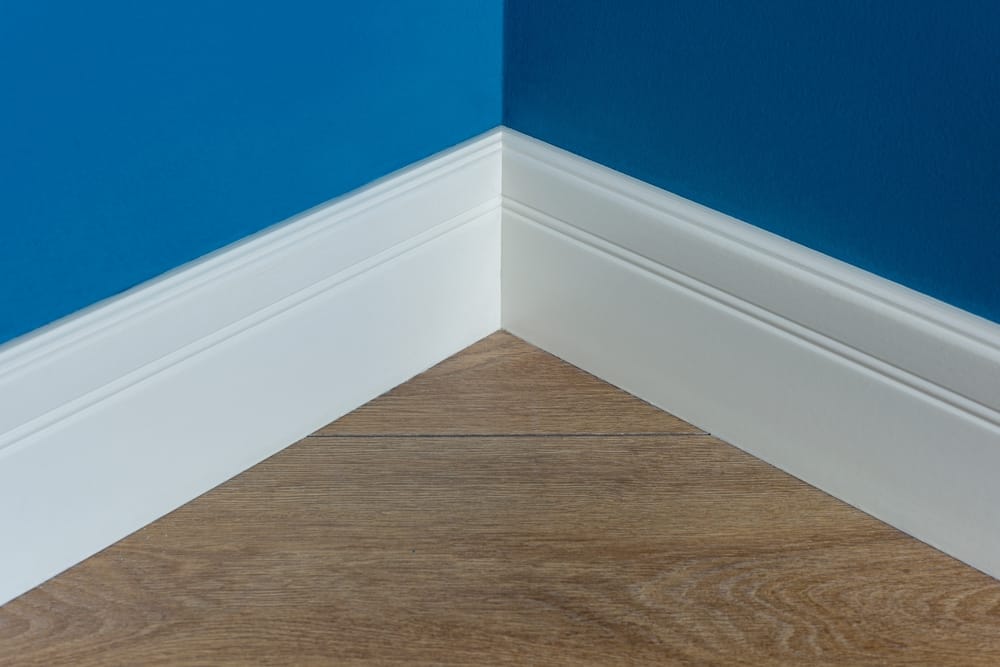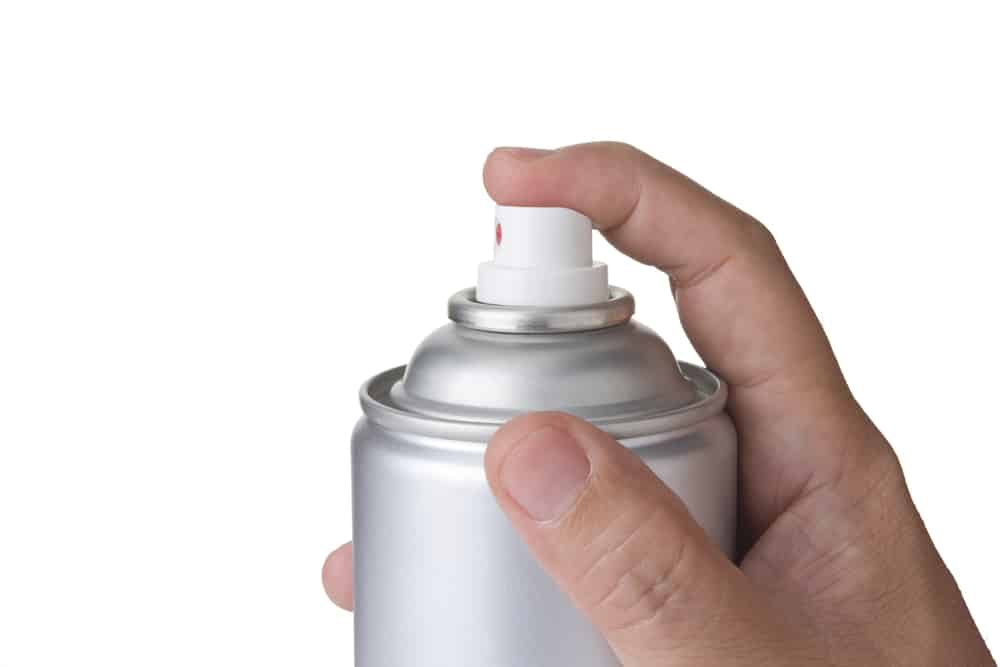How To Get Paint Off Trim

After a hard job of painting the walls, you may realize that some dripped onto your baseboards.
Leaving the paint there can make your home look messy and unprofessional.
Luckily, there are a few different ways to remove it.
We'll give you a step-by-step guide on various methods to get rid of paint on your baseboards.
How To Get Dried Paint Off Baseboards (Step-By-Step Guide)

Method 1: Sandpaper And Paint Remover

This method only requires sandpaper, paint remover, and some elbow grease.
Follow these steps to remove paint from a baseboard without damaging the grain.
Step 1: Gather Materials

For this method, you'll need 80-grit sandpaper and your choice of paint remover.
At the very least, the paint remover should be safe to use on trim or wood.
An aerosol can is the best type of paint remover for this particular method.
Masking tape is also useful if you don't want to remove the baseboard from the wall.
It can keep the paint remover from getting onto your newly painted walls.
It can also protect the floor.
Step 2: Remove Baseboards Or Apply Masking Tape

At this stage, you need to decide if you want to remove the baseboard or not.
Removing it does take extra effort, but it also gives you greater comfort and flexibility later.
All you need to do to remove the baseboard is to carefully take out the nails or screws.
If you don't want to remove the baseboard, then you'll want to apply your masking tape.
It needs to be wide enough to cover the bottom part of the wall.
Aerosol cans can splatter, and the mist can travel.
Ensuring the masking tape is high enough on the wall will preserve your paint job.
Add some masking tape to the bottom edge of the baseboard where it meets the floor.
This will further protect the floor from becoming damaged by the paint remover.
Step 3: Spray The Paint Remover

Spray the can of paint remover along the baseboard.
An even coat is important.
If you took the baseboard off of the wall, then you can manipulate the board as needed to get every angle.
If you didn't remove the baseboard, then you can do your best at moving and angling the spray to hit the entire surface.
Step 4: Let Remover Sit For A Few Minutes

You need to let the paint remover sit for a while.
The duration depends on the amount of paint you're removing.
If the paint has several layers, then you should let it sit for 15–20 minutes.
Even a half-hour won't hurt.
For thin layers of paint, you only need to let the remover sit for 10–15 minutes.
Step 5: Clean Off The Remover

Using a scrap piece of wood or cloth, run it up and down the baseboard.
You only want to remove the surface level of the paint remover.
Allow the paint remover to soak into the wood still.
Focus on cleaning the residue that's left behind on the surface.
Step 6: Let The Baseboard Dry

You can't sand the baseboard until it's dry.
It's difficult to sand wood that's wet.
It can take several hours for the baseboard to dry, depending on how much paint remover is on it.
You may need to let it dry overnight.
Step 7: Sand Baseboards Along The Grain

After it's dry, you'll notice that the wood may still have a hue of color to it.
Sanding it can remove the hue.
Take your 80-grit sandpaper and sand the baseboard with the grain.
If you sand it against the grain, then the stain will look odd afterward. It can make it look choppy.
Sand the baseboard several times.
It may take a long time until it's smooth and the paint is completely removed.
Eventually, the baseboard will be back to its original color and have a polished surface.
Method 2: Dull Knife, Damp Rag, Cleaning Solution, Hairdryer, Solvent-Based Cleaner, And Sandpaper

If the steps above don't work, then you may need to add in a few cleaning solutions.
Follow these steps if you have a thick paint drip or stubborn paint.
Step 1: Carefully Cut Away Drips

A dull knife is useful for cutting away paint drips.
Sharper knives can damage the wood beneath the paint drip.
Something like a butter knife is ideal.
Using the dull knife, scratch beneath the paint drip, and peel it away.
If the drip refuses to budge, don't force it.
ou might end up cutting into the wood of the baseboard.
Step 2: Place A Damp Cloth Over The Dried Paint

If the drip remains, then dampen a cloth with water.
A microfiber cloth is the most effective type.
Press the damp cloth against the paint.
The moisture can make the paint lose adhesion to the wood.
Once it's damp enough, try to peel it away with the dull knife again.
If this still doesn't work, then proceed to the next step.
Step 3: Use A Cleaning Solution

If the water isn't doing anything, then you need to try a cleaning solution.
The cleaning solution needs to be gentle.
Dish soap is a great choice.
Apply a small amount to the damp cloth.
Then rub it around the cloth to spread it.
Press the cloth against the paint for some time.
Then try and peel it away with the dull knife.
This step is not ideal for oil paints.
Step 4: Heat The Area With A Hairdryer

If you're worried about making your baseboards wet, then you can choose to use a hairdryer instead.
Heat can sometimes loosen the adhesion between paint and the wood, too.
It also softens the paint.
Place the hairdryer on high and direct it at the drips of paint.
Heating the paint at a 45-degree angle is effective.
After a few minutes, you can try to peel the paint away with the dull knife again.
This step is ideal for oil paints.
Step 5: Use A Solvent-Based Cleaner

Sometimes you need to use a heavy-duty cleaner to remove paint drips.
In the case of latex paint, it responds well to denatured alcohol.
Pour some into your damp cloth and dab it against the paint drips.
You can also hold it against the baseboard.
You'll want to be gentle when dabbing as it can ruin the finish of the baseboard.
Step 6: Finish Off With Sandpaper

The last step is to use sandpaper.
Before you start sanding, let the baseboard dry completely.
Then use 80-grit sandpaper to sand away the drips of paint.
Move slowly and watch your progress.
You can wear the wood down if you're not careful.
This step can also remove oil-based paint.
Method 3: Paint Stripper And Wire Brush

An easy method to remove paint from a baseboard is to use a paint stripper and a wire brush.
You'll need to apply some strength when you're scrubbing.
You'll also need protective equipment.
Follow these steps to get dried paint off baseboards.
Step 1: Gather Materials

This method requires a paint stripper, a wire brush, masking tape, safety goggles, and solvent-protected gloves.
Masking tape can protect the floor from the paint stripper.
It can also protect the wall if you want to protect the paint job you finished.
Safety goggles are necessary to keep your eyes safe.
Paint strippers can seriously harm your eyes if the mist reaches them.
Solvent-protective gloves are also required.
A paint stripper should never touch your skin.
It's inevitable that some of it will leak from the can or bottle that you're using.
The gloves will keep the liquid from damaging your skin.
Step 2: Apply Masking Tape

Paint stripper is powerful.
You can keep your wall and floor safe by applying masking tape to the areas.
If you're messy, then be generous with the masking tape.
Step 3: Rub Wire Brush Along Baseboards

Begin by brushing the wire brush along the baseboards.
This will irritate the paint and cause it to rise.
The paint stripper can work better as a result.
Using the wire brush can also remove some drips and flakes of paint from the baseboard.
Run the brush along the grain if possible.
Step 4: Spray The Paint Stripper

Depending on the type of paint stripper you bought, you need to spray it or apply it with a paintbrush.
Spray the paint stripper directly against the baseboard.
If you need to brush it on, then brush the paint stripper along the baseboard.
Do not forget the top of the baseboard.
Step 5: Scrub With Wire Brush

Don't wait too long to scrub the paint stripper with the wire brush.
The stripper works fast.
Using the wire brush on the baseboard can remove paint as it's stripped.
The wire brush should act as a scrubber.
You're scrubbing the paint stripper deeper into the baseboard.
Step 6: Wait For The Stripper To Soak In

Apply another coat of paint stripper and let it soak into the baseboard.
This step can take some time.
The amount of time you need to wait is on the can.
In some cases, you only need to wait a few hours.
In others, you need to wait 24 hours.
It depends on how many layers of paint you are trying to strip.
The more layers there are, the longer the paint stripper needs to work.
To get the best results, let the paint stripper soak for 24 hours.
Step 7: Use Wire Brush Again To Remove Paint And Stripper

After the paint stripper has completely soaked the baseboard, you can use the wire brush.
Most of the paint will remove with ease.
If some paint still sticks to the baseboard, then you can use a hairdryer to heat those problem areas.
The hairdryer needs to be on high.
Once the heat softens the paint, you can remove it with the wire brush.
Otherwise, the paint stripper will remove the rest.
You're left with bright and unpainted baseboards.
Method 4: Paint Eater And Scraper

This method is like the others except it uses a scraper and heat gun.
The paint eater is also different from the paint remover and stripper.
It's like a sander in that it rips paint from the surface.
You'll need to smooth the baseboard afterward.
This method is messy and best for those who can remove their baseboards from the wall first.
Step 1: Gather Materials

You'll need to find a paint eater in your local hardware store.
Wagner sells a high-quality paint eater that's tough on paint but gentle against the wood.
You'll also need a smaller scraper to get the areas that the paint eater can't reach.
A heat gun is also required to help soften the paint beforehand.
Finally, you'll need safety goggles and gloves.
Working with a paint eater is very messy.
Step 2: Apply Heat To Baseboards

Begin by applying heat to the baseboards.
Angle the heat gun at 45-degrees and keep a distance of one to three inches away.
Heat the area until the paint softens.
Step 3: Scrape Softened Paint

Before the paint cools, use the scraper to remove the initial surface of the paint.
You'll want to aim for the areas that the paint eater can't easily reach.
Corners and the tops of the baseboard are ideal places to use the scraper.
Try to be gentle when scraping to keep from damaging the baseboard.
Step 4: Use Paint Eater

Carefully run the paint eater along the baseboard.
You don't want to press too hard into the wood.
The paint eater will scratch and chew the paint away.
If possible, run the paint eater along the grain of the baseboard.
Going against the grain can chew the wood up.
Step 5: Scrape Remaining Paint

After the paint eater, use the scraper to scrape away any remaining paint.
There may be a few areas where the paint eater missed.
Step 6: Sand The Area Down

You'll need to sand the area down to give it a polished finish once more.
80-grit sandpaper is effective at removing any chewed areas and smoothing the baseboard down.
After sanding, the baseboard won't have paint and will be smooth and polished.
Method 5: Paint Remover, Contoured Scraper, Sandpaper, Wood Bleach

This method uses a special kind of contoured scraper that is designed for a baseboard's top.
Wood bleach is also useful in removing paint that has soaked deep into the wood.
Step 1: Gather Materials

The tools you'll need for this method to remove dried paint from baseboards are paint remover, a contoured scraper, 80-grit sandpaper, and wood bleach.
The wood bleach needs to be able to remove pigment colors specifically.
You'll also need to wear safety equipment.
Goggles and gloves can keep your hands and eyes safe from paint remover and wood bleach.
Step 2: Spray Paint Remover

Begin by spraying paint remover against the baseboard.
An even coat will ensure the remover is able to soak into the wood uniformly.
Let the remover soak into the wood for a few minutes.
You don't want to wait until it dries, but it needs to soak into all the layers of paint.
Step 3: Use Contoured Scraper To Remove Paint

A special tool that uses a contoured blade can scrape the top of the baseboard.
It's also useful for removing paint from the sides.
Something like the Hyde contoured scraper is a great choice.
It's sharp, so you'll want to be careful using it on the baseboard.
It can cut into the wood if you're not careful.
Run the scraper along the baseboard to remove the paint.
Step 4: Sand The Baseboard

Let the baseboard dry if it isn't already.
Then use the 80-grit sandpaper to sand it.
The sandpaper will remove the rest of the paint that's lingering on the surface.
Go in the direction of the grain to keep it smooth.
This will also make your stain look professional.
Step 5: Apply Wood Bleach

Even after sanding, you may notice that the wood still has a slight hue to it.
No amount of sanding or paint remover will remove it.
The pigment is too deep in the wood.
The best solution is to use a wood bleach that covers up pigments.
Putting a fresh coat of paint on the baseboard can give it a fresh and new appearance.
Any lingering pigments beneath it won't be noticeable.
You can apply the wood bleach with a rag.
Place down masking tape if you're worried about a mess.
Then run the rag along the baseboard until the hue is gone.
Then let the wood bleach dry.
You may need a few coats of wood bleach to get the result you need.
Step 6: Sand Again

An unfortunate consequence of wood bleach is that it makes the grain rise.
You need to run the sandpaper over the baseboard again to smooth it.
First, let the baseboard completely dry from applying wood bleach.
Then run the sandpaper along the baseboard once more.
It won't take long to smooth it.
Step 7: Apply Stain Or Paint

At this point, the baseboard is ready for staining or painting.
The pigments in the paint and the color in the stain won't mix with the wood bleach or the pigments beneath it.
Only the stain or paint you choose will be noticeable.
What Products Can Remove Paint From Baseboards?

There are a few products that you can use to safely remove paint from your baseboards.
They're effective and some of them are safe to use in the home without worrying about toxic fumes.
1. Goof Off

Goof Off has several different strengths based on your needs.
Each product is also useful for a particular surface.
For example, one solution is best for hardwood floors while others are better for plaster.
They also have products to remove specific types of paint.
If you have oil-based or latex paint, then you can find the paint remover you need with Goof Off.
2. Vegetable Oil

Vegetable oil is useful for softening paint.
It won't strip the paint for you, but it can make it soft enough to scrape away.
Almost every home has vegetable oil which makes it an affordable option for removing paint.
It's also safe to use in the home around children and pets.
3. CitriStrip

CitriStrip is a paint remover that also removes varnish.
It's ideal for paint jobs that contain a lot of layers of paint.
It's able to soak through them and remove them.
Despite its power, it's also safe to use indoors around pets and children.
Conclusion

Removing dried paint from baseboards requires some work.
You need a paint remover, stripper, or eater to dig deep into the paint.
You also need a scraper and sandpaper to scrape away the lingering paint.
Using either a hairdryer or heat gun can soften the paint and make it easier to scrape away.
If the paint gives the wood a colorful hue, then using wood bleach can remove it.
The methods above are effective at removing paint from baseboards.
Try the one that works best for you.
How To Get Paint Off Trim
Source: https://www.homemindset.com/how-to-get-dried-paint-off-baseboards/
Posted by: harkinsstroffeld89.blogspot.com

0 Response to "How To Get Paint Off Trim"
Post a Comment